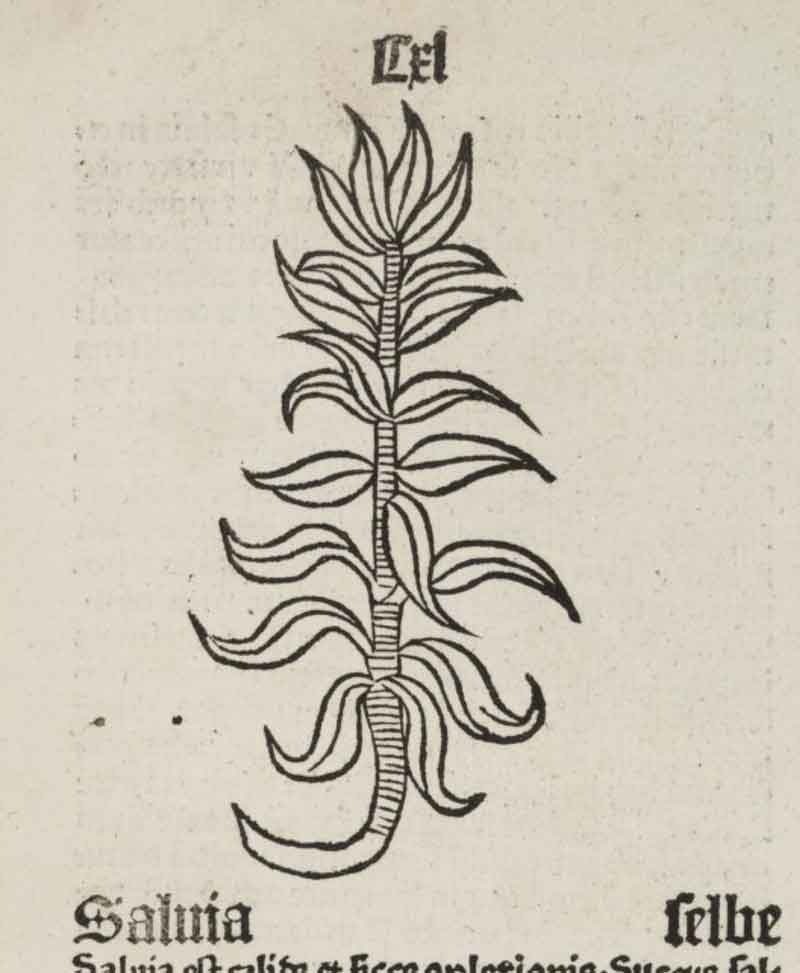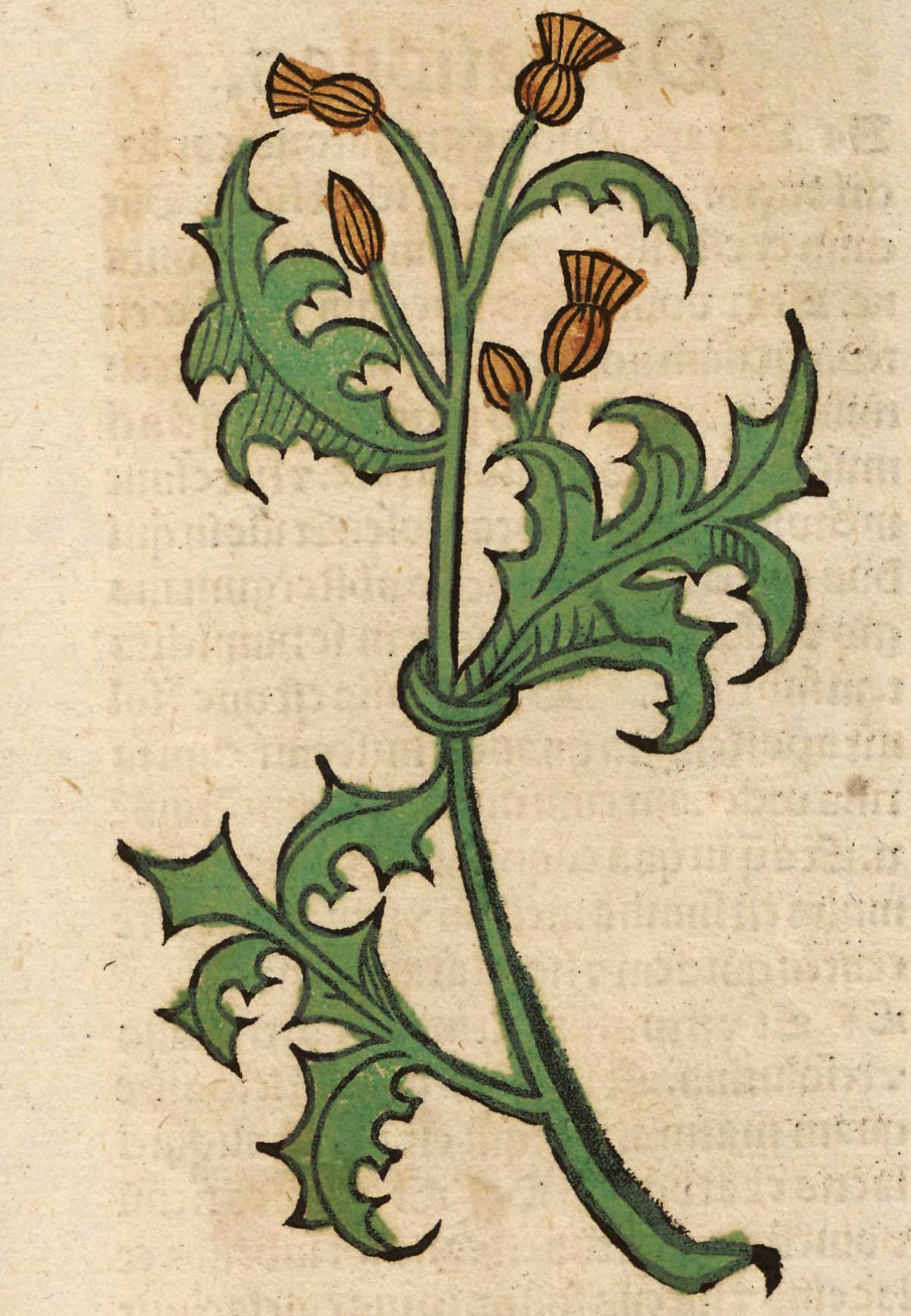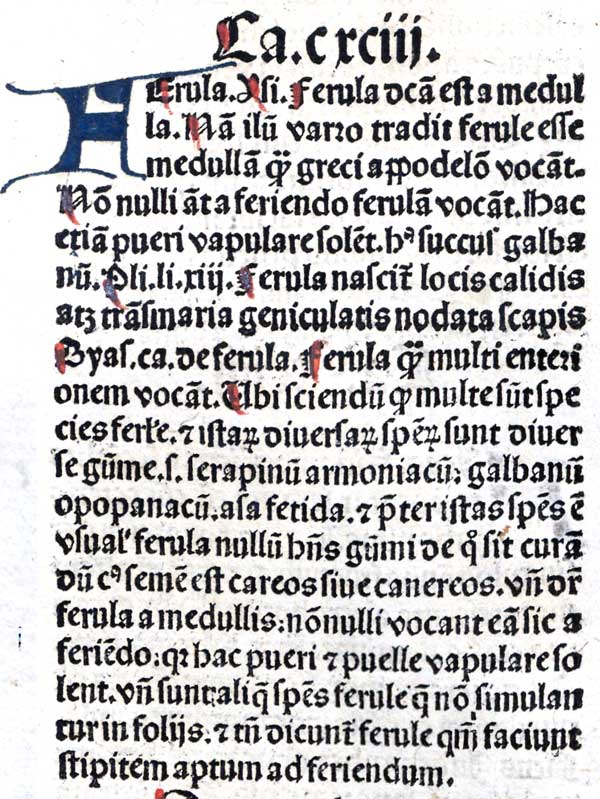From the root goes forth a unique stalk, round, ferulaceous, green on the outside, blanched within
Original French: De la racine procède vn tige vnicque, rond, ferulacée, verd au dehors, blãchiſſant au dedans:
Modern French: De la racine procède une tige unicque, rond, ferulacée, verd au dehors, blanchissant au dedans:
Notes
blanchissant
Blanchir. To blanch, white, whiten, make white.
Salvia
Ferula
Ferula (text)
plantes férulacees
Again there are differences in the ‘core’: in the first place according as plants have any or have none, as some say is the case with elder among other things; and in the second place there are differences between those which have it, since in different plants it is respectively fleshy, woody, or membranous; fleshy, as in vine fig apple pomegranate elder ferula; woody, as in Aleppo pine silver-fir fir; in the last-named especially so, because it is resinous. Harder again and closer than these is the core of dog-wood kermes-oak oak laburnum mulberry ebony nettle-tree.
The cores in themselves also differ in colour; for that of ebony and oak is black, and in fact in the oak it is called ‘oak-black’; and in all these the core is harder and more brittle than the ordinary wood; and for this reason the core of these trees can not be bent. Again the core differs in closeness of texture. A membranous core is not common in trees, if indeed it is found at all; but it is found in shrubby plants and woody plants generally, as in reed ferula and the like. Again in some the core is large and conspicuous, as in kermes-oak oak and the other trees mentioned above; while in others it is less conspicuous, as in olive and box. For in these trees one cannot find it isolated, but, as some say, it is not found in the middle of the stem, being diffused throughout, so that it has no separate place; and for this reason some trees might be thought to have no core at all; in fact in the date-palm the wood is alike throughout.
ferula-like plant
With spineless plants it is not possible to make such ‘generic’ distinctions; for the variation of the leaves in size and shape is endless, and the differences are not clearly marked; but we must try to distinguish on another principle. There are many classes of such plants and they differ widely, as rock-rose bryony madder privet kneoron marjoram savory sphakos (sage) elelisphakos (salvia) horehound konyza balm, and others like these; and in addition to these we have the plants with a ferulalike stem or with a stem composed of fibre, as fennel horse-fennel narthekia (ferula) narthex (ferula) and the plant called by some wolf’s bane, and others like these. All these, as well as any other ferula-like plants, may be placed in the class of under-shrubs.
The class of ferula-like plants (for this too belongs to the under-shrubs) comprises many kinds: here we must first speak of the characteristic which is common to all, including ferula itself4 (narthex) and narthekia, whether they both belong to the same kind and differ only in size, or whether, as some say, they are distinct. The obvious character of both is alike, except as to size; for narthex grows very tall, while narthekia is a small plant. Each of them has a single stalk, which is jointed; from this spring the leaves and some small stalks; the leaves come alternately—by which I mean that they do not spring from the same part of the joint, but in alternating rows. For a considerable distance they embrace the stalk, like the leaves of the reed, but they turn back from it more owing to their softness and their size; for the leaf is large soft and much divided, so that it is almost hair-like; the largest leaves are the lowest ones next the ground, and so on in proportion. The flower is quince-yellow and inconspicuous, the fruit6 like dill, but larger. The plant divides at the top and has some small branches, on which grow the flower and the fruit. It also bears flowers and fruit on the side-stalks all the way up, like dill. The stalk only lasts a year, and the growth takes place in spring, the leaves growing first and then the stem, as with other plants. It roots deep and has but a single root. Such is the ferula.
Of the others some to a certain extent resemble ferula, that is, in having a hollow stem; for instance deadly nightshade hemlock hellebore asphodel: while some have a stem more or less, as it were, consisting of fibre, as fennel aconite and others like these. The fruit of deadly nightshade is peculiar in being black and like a grape and like wine in taste.
ferule
Et ferulam inter externas dixisse conveniat arborumque generi adscripsisse, quoniam quarundam naturae, sicuti distinguemus, lignum omne corticis loco habent forinsecus, ligni autem loco fungosam intus medullam ut sabuci, quaedam vero inanitatem ut harundines. calidis nascitur locis atque trans maria, geniculatis nodata scapis. duo eius genera: nartheca Graeci vocant adsurgentem in altitudinem, nartheciam vero semper humilem. a genibus exeunt folia maxima ut quaeque terrae proxima; cetera natura eadem quae aneto, et fructu simili. nulli fruticum levitas maior; ob id gestatu facilis baculorum usum senectuti praebet.
It may be suitable to have fennel giant [Ferula communis] mentioned among the exotics and assigned to the genus ‘tree,’ inasmuch as the structure of some plants, in the classification that we shall adopt, has the whole of the wood outside in place of bark and inside, in place of wood, a fungous pith like that of the elder, though some have an empty hollow inside like reeds. This fennel grows in hot countries over sea; its stalk is divided by knotted joints. It has two varieties, one called in Greek narthex, which rises to some height, the other narthecia, which always grows low. From the joints shoot out very large leaves, the larger the nearer to the ground; but in other respects it has the same nature as the dill, and the fruit is similar. No shrub supplies a wood of lighter weight, and consequently it is easy to carry, and supplies walking-sticks to be used by old gentlemen.
ferula
Est et haec natura ut alii alibi pisces principatum optineant, coracinus in Aegypto, zaeus, idem faber appellatus, Gadibus, circa Ebusum salpa. obscenus alibi et qui nusquam percoqui possit nisi ferula verberatus; in Aquitania salmo fluviatilis marinis omnibus praefertur.
It is also a fact of nature that different fishes hold the first rank in different places … the saupe in the neighbourhood of Iviza, though elsewhere it is a disgusting fish, and everywhere it is unable to be cooked thoroughly unless it has been beaten with a rod…
ferulacée
Ferulacé: Round, also, of the kind of the herbe Ferula.
Ferule: A Ferula, or Paulmer used in Schooles for correction; also, the herbe Ferula, Sagapene, Fennell Giant; also, a reed, or cane.
ferule
FÉRULE. T. de Botan. Genre de plantes ombellifères qui croissent principalement dans les régions méridionales, et dont une espèce, originaire de Perse, fournit l’Assa foetida, employée souvent comme antispasmodique. Chez les anciens Romains, les maîtres d’école se servaient d’une tige de férule pour châtier leurs écoliers.
Il se dit, dans le langage ordinaire, d’Une petite palette de bois ou de cuir dont on se servait autrefois pour frapper dans la main des écoliers, lorsqu’ils avaient fait quelque faute. Un maître d’école qui a toujours la férule à la main.
ferulacée
Sembable à la tige fistuleuse de la férule qui est, d’aprés Fée, Ferula communis, L. (Ombellifére). Le caractère de la férule, dit Pline, est d’être divisée en tiges partagées par des nœuds: geniculatis nodata scapis (H.N., XIII, 42). Cette tige est grosse, fongueuse, crusée d’une canal médullaire, [medulla] carnosa… ferulæ, dit Théophraste, l. I, ch. 9, assez solide pour servir de bâton, et néanmoins assez lègère , pour ne pas blesser ceux qu’elle frappe. Pline, H.N. XIX, 56, range le chanvre, avec la thapsie et le fenouil, parmi les plantes férulacées. (Paul Delaunay)


